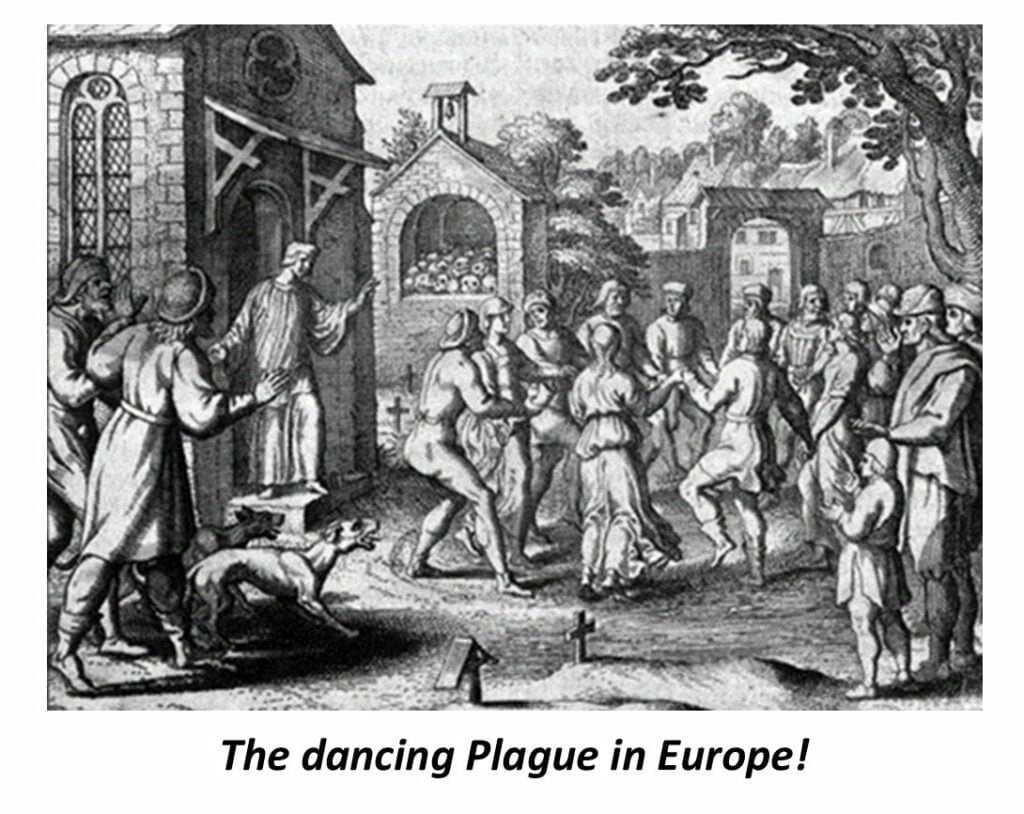
Today we dance for fun, we can dance all night, and we think nothing of it, but in the 14th century they thought it was a disease!
They called it the “Dancing Plague”. Between the 14th and 17th centuries in European towns people would suddenly start dancing erratically, then others joined them, sometimes this grew to thousands.
The religious authorities didn’t like it
Of course, they didn’t, they were convinced it was a disease from the devil, you see sometimes people danced until they collapsed from exhaustion! It became known as ‘St Vitus’s Dance’, while the sophisticated called it “choreomania” and regarded it as a mental illness or even something worse.
Where did it start?
The first recorded big dance happened in Aachen in Germany in 1374, they then happened for several centuries as thousands of people across Europe got “Dancing Mania”. After the Aachen dance they were reported in Cologne, Flanders, Utrecht, and even as far away as Italy. When in in Strasbourg in July 1518 Frau Troffea started dancing within a month there were 400 dancing with her. Many it appeared suffered heart attacks and died, which doesn’t surprise me when dancing for that long!
How did the Religious Authorities react?
They didn’t understand it, all they could see was that it was highly contagious, they got worried. With a multiplicity of bizarre ways they tried to stop this highly infectiousdisease, dancing! Their maddest idea was when they came up with the idea that musicians should accompany dancers, thinking the dancers would stop and listen to the music. How wrong could they be that wrong!
They then looked for reason why it was happening.
They looked and came up with a variety of theories.
- Where people dancing to forget the stress and poverty of their lives?
- Was this a mass psychogenic illness, whose physical symptoms were dancing in groups.
- Some thought it was a curse brought about by St Vitus, a Christian saint from Sicily.
This led to a series of pilgrimages to places dedicated to St Vitus, which appeared to stop some people dancing. To the church this confirmed the link between dancing and the saint.
Of course in those days they didn’t have autopsies, so, it was easier to put the cause of death as the “Dancing Plague”.
Amazing isn’t it, how the world has changed and how today, we love to dance.
However, remember, once it was a disease!
Isn’t history fun?
10 questions to discuss:
- What were some of the common symptoms exhibited by those affected by the Dancing Plague?
- How did the Dancing Plague impact the social fabric of European towns during the 14th to 17th centuries?
- What role did religious authorities play in attempting to contain the spread of the Dancing Plague, and what were some of their methods?
- How did the Dancing Plague affect the mental health perceptions of the time?
- What were some of the theories proposed to explain the cause of the Dancing Plague?
- How did the spread of the Dancing Plague affect different regions of Europe?
- What measures were taken by communities to try to stop the Dancing Plague from spreading further?
- How did the Dancing Plague contribute to the development of medical understanding during the Middle Ages?
- What was the significance of St. Vitus in relation to the Dancing Plague?
- How does the historical phenomenon of the Dancing Plague compare to contemporary understandings of mass hysteria or psychogenic illnesses?
For more on this amazing phenomena:
https://allthatsinteresting.com/dancing-plague
© Tony Dalton

